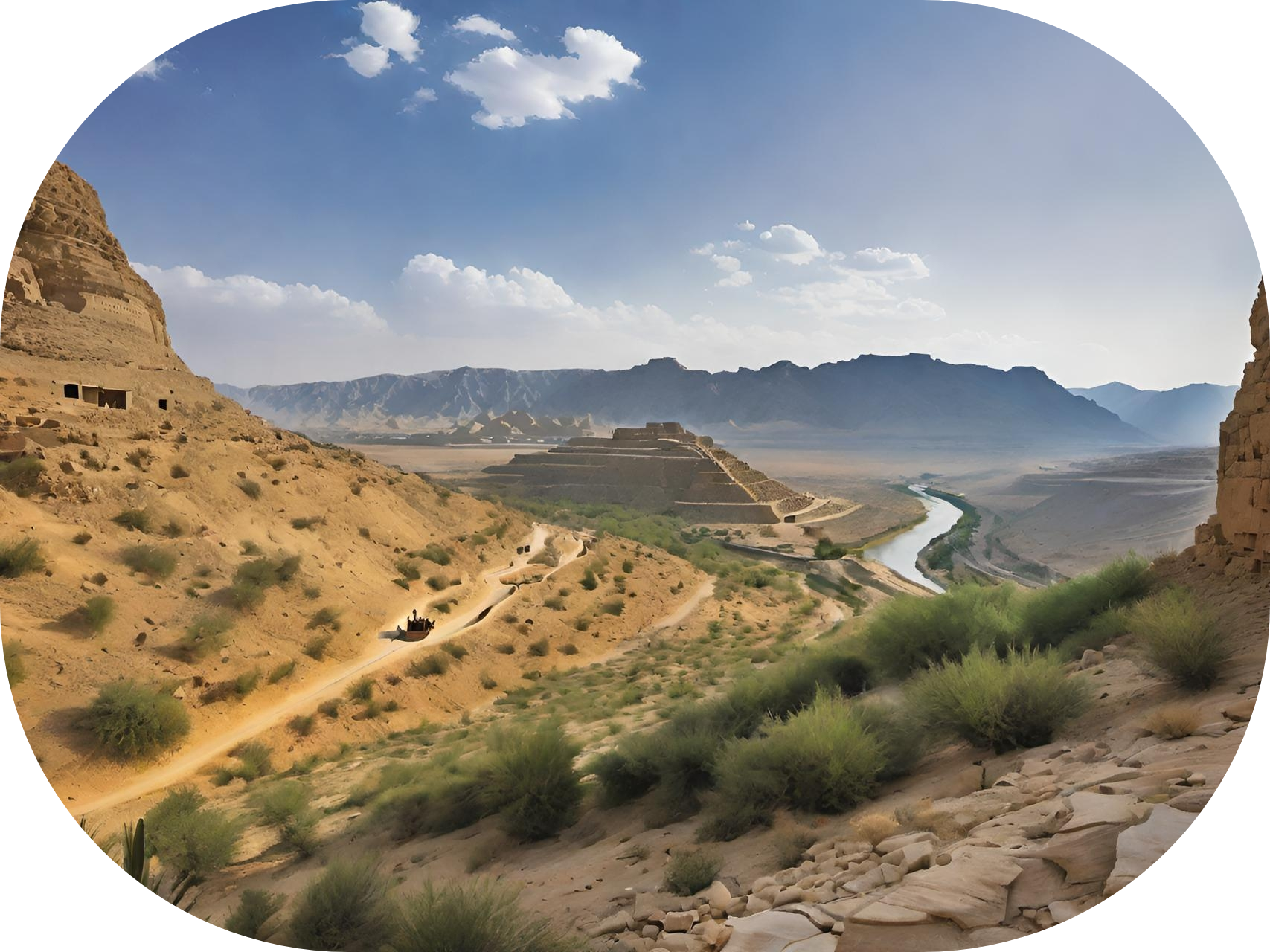Birit Narim
All regions of the Shamsi Desert feel the influence of Lithmor, of her intense yet nurturing light, but Birit Narim is host to Lithmor's Seat, Dawn Ahrayn. Ethereal waters infused with solar energy, glowing like the dawn itself, pour out from Dawn Ahrayn and breath life into arid desert regions. These lands are also famous for the countless illusions which project across the sky and mountains in the night--some of which are echoes of the past! Mythical white towers and daunting illusory cities, colorful murals and animated folktales, even wisps of the long dead dance in the night, performing plays or celebrating festivals! These are ancient memories pulled from Kalitho and Kanilwyr's Planes, keeping the joys of the past alive. Monuments can be found throughout Birit Narim, containing precious memories, history or even more personal moments. Weddings, funerals, coming of age, preserved through time in stone and light! Three rivers welcome the waters cascading from Dawn Ahrayn above, the Purattu and Idiqlat flowing north while waters flowing south merge with al-Nil River. The radiant waters of Dawn Ahrayn are the lifeblood of Birit Narim. Everywhere these waters touch, plant life springs in abundance, making these fertile lands sought after especially by neighbors from less verdant desert territories. When Lithmor still walked Emynea, she built her Seat here in order to watch over Birit Narim but now that their goddess is gone, they have fallen prey to Ilnid and his Khalifah al-Rasul.
There are two main ethnic groups indiginous to Birit Narim, the Siryan and Kurdish peoples, but the Arabiyy have also made themselves at home. In contrast, inhabitants of Dawn Ahrayn are far more mixed. They descend from those handpicked by Lithmor, serving their goddessv directly and inheriting the strongest of her blessings. Now they guard her Seat and the headwaters spilling from Dawn Ahrayn. While ethnically diverse, there is a majority of Masriyyin and sub-Shamsi Alkelbulians among them. Within Birit Narim, Lithmor went by the name Shamash, the mythological goddess of the sun, justice and divination. It is said when she was slain, a double eclipse occurred, the sky going dark in her absence. |
Habitats |
|---|
ShrublandMontane |
SteppeSemi-Desert |
FreshwaterWetland |
UrbanRural |
Elemental Influence |
|---|
|
|
|
Other Names |
|---|
Kengir |
Mat Akkadi |
Mat Babil |
Babilim |
Settlements |
|---|
Geography |
The southernmost region of Birit Narim is characterized by high, precipitous mountains which border Kemet and Aznag. Dawn Ahrayn can be seen from afar, hovering over the tallest peak of the Urartu Mountains, Mount Ararat. These were once connected to Sesli Plato, separated by the Erlithmanil as they reshaepd Emynea. There are those who travel to Kemet just to catch a glimpse of this radiant city, as no outsiders are permitted. Her guardians, Zalag Ennun, won't allow outsiders near Lithmor in her compromised state, using potent light magic to deal with trespassers. The Urartu Mountains slope slowly northward, guiding the Idiqlat and Purattu Rivers towards the sea. The majority of roadways center around gentle Purattu as Idiqlat cleaves through the mountains with far steeper slopes. Birit Narim is arid or semi-arid in climate, transforming into desert the further one travels from these rivers. Meanwhile, northern territories transform into marshes, lagoons, mudflats and reed strewn banks as the land levels out. Idiqlat and Purattu merge amid these marshes just before reaching the sea.
While those in southern Birit Narim rely on rain to water their fields, irrigation by canals becomes more prevalent the further north one travels. The climate also becomes colder and colder but the solar energy in the Idiqlat and Purattu rivers warms the earth and air it touches, a benefit which disipates farther from these waterways. Melting snow further dilutes the solar water in the marshes, the water gradually losing its shine by the time it meets the sea. Outside of agriculture along the riverbanks, nomadic pastorialists guide their herds of sheep, tamadla goats and shamsi camels throughout the countriside and amid craggy slopes. In the summer, they graze on river pastures and in winter, the wet season, they move to the fringes of the desert. Meanwhile, fishing is more prevalent in northern Birit Narim within its marshes. Left to their own divices, the tribes and settlements of Birit Narim aren't prone to uniting into one large nation. They prefer the formation of city-states, fragmented tribes in montane villages or living nomadically by sleeping in tents--though farmers and nomads often butted heads. This isn't to say their civilization wasn't advanced. In fact, it was a center for human development and one of the few reliably fertile locations in northern Alkelbulan alongside Kemet! Civilizations large and small rose and fell continuously between these two rivers and many kings of Birit Narim still live on in legend. However, these small, vying powers fell before outside empires beginning with the conquest of Alexandros and then Ilnid. A Quiris-Hellenes empire maintained a tight grip even after their conqueror met his end, a few small kingdoms rising against them but never quite pushing them out. The people of Birit Narim might have recovered with Lithmor's aid but once she was sealed away, and they fell under the abrasive reign of Ilnid, not a single kingdom has risen successfully to oppose Arabiyy control. Much like their neighbor Kna'an, Ilnid holds onto Birit Narim with an uncompromising grip. |
History |
Conquerors from surrounding lands have all, at some point, attempted to possess the abundant fields of Birit Narim and some believe these lands are cursed to endless tragedy. Even within Khalifah al-Rasul, wazir and khalifah bicker and plot to possess pieces of this territory. Despite frequently falling under the rule of foreign powers, Birit Narim has always been one of the earliest civilizations in Alkelbulan thanks to its fertility and as the home of Lithmor, her aspect Kanilwyr being the element of knowledge. Well fed and watched over by their goddess, Siryans were the first to develop writing, mathematics, astronomy and agriculture following the Birth of the Erlithmanil. |
Kengir City-States |
Directly after the Birth of the Erlithmanil, the Saggigga people were first to establish civilization in northern Alkelbulan under Lithmor's guidance, calling their country Kengir. They were early agriculturists, growing enough to have a surplus to support urban growth. Unlike most inhabitants of the area, they did not fall into the al-Mashriq ethnic group. Instead, these were Nil-Shamsi peoples from Nyasi za Rangi and Kasar Wuta who had earned Lithmor's respect and patronage, migrating to be closer to her Seat. They lived alongside locals as a cult worshipping Lithmor, helping her to spread knowledge of agriculture, writing and science. They drained marshes to make fields, propogated trade and taught skills such as weaving, leatherworking, smithing, masonry and pottery. There were three main lifestyles in this time, farmers living in mud-brick huts, nomadic pastoralists living in tents and following herds of sheep and goats and that of fisher folk, living in reed huts in the marshlands. A long dynastic period took root, major city-states and their kings included Alulim of Unug, Dumuzid of Eridug, Ensipadzidana of Laraak, Enmendurana of Zimbir, Ziudsura of Suruppag, Enmebaraggise of Kis, Mesannepadda of Urim and Pieli of Awaan. The famous hero Bilgames, or Gilgames to the Akkadi people, also lived during this period as a king of Unug. Bilgames is rumored to have been Banalkar in a human guise or to be his descendant but only the ancients know for sure. |
Mat Akkadi |
At the end of the dynastic period, the first empire in Birit Narim arose: Mat Akkadi. These were an al-Mashriq people led by their king, Sarruumkiin, who conquered 34 cities himself! Several Kengir city-states rebelled amid his rule, Sarruumkiin and his son Rimuus reconquering at least six cities. Palaces, temples and walls were built in his lands with the spoils their conquests. Akkadi stretched all the way into Kna'an, Parsa and parts of the Frozen Wastes. While their founder revered the local pantheon and had the blatent endorsement of Ishtar (Ferith), his descendants were less than respectful of the gods. Some accounts even claim Sarruumkiin was a Divine Descendant of Ferith and this was why he was not only so powerful in battle but why Lithmor took no direct action against him. So fearsome in battle was Sarruumkiin that even in old age he continued to smite revolts against him, including a siege on his capital.
Once Rimuus came into control, he unleashed a violent campaign against Saggigga city-states, slaughtering more than 50,000 of them and enslaving or expelling nearly as many more! He even went so far as to erect monuments recording and proclaiming his genocidal exploits, struggling against rebellions until his own courtiers assassinated him. Rimuus was succeeded by his elder brother, Maanishtusu, who became renown for his victory in a naval battle against 32 kings from al-Arabiyyah. Yet Rimuus too was assassinated amid court politics. The following King Naraam Sin, Maanishtusu's son, was perhaps the most reviled. He continued his predecessor's trend of conquest and proclaimed himself Lugal Naraam Sin, Sar kibrat 'arbaim meaning King Naraam Sin, Ruler of the Four Courners, of the entire world. He was skilled in both battle and diplomacy, pushing the Akkadi empire to its largest expanse. Most contriversial was his proclimation that he, and his ancestors, were not representatives of the gods but actual deities themselves. While Birit Narim was well organized and productive during his reign, resulting in a high surplus of food and the construction of extensive public infrastructure, Naraam Sin invaded many neighboring lands and confiscated their wealth to further these advances. His attempt to deify himself pushed Birit Narim into the Great Revolt. Leading up to this, Naraam Sin began tightening his control over his city-states by sending his sons as governors and his daughters as high-priestesses—a tactic later adopted by Khalifah al-Rasul. He kept only the most loyal to him as governors. Despite his attempts to consolidate power, a coalition formed amid his city-states and rebelled together against him. Yet much like his grandfather, Naraam Sin possessed powerful fire magic and emerged victorious battle after battle. It was following these victories that he proclaimed himself divine and named himself god of his capital, Akkan. |
Fall of Akkadi |
Contradictory accounts recall the fall of the Akkadi empire, some claiming it was the fault of Naraam Sin while others claim it was the mistakes of his successor. What is clear is that while Naraam Sin was unmatched in battle and diplomacy, his son and heir Sharkali Sharri proved less competent. Either Naraam Sin himself or Sharkali Sharri made a fatal, vain mistake: while Lithmor was abroad the king of Akkadi attacked Enkur, Lithmor's Seat of this era and the holy temple of the gods, pilfering their offerings and defiling their temples.
Some claim this was Naraam Sin in a final show of arrogance while others believe Sharkali Sharri did so as a show of force, facing numerous rebellions and the collapse of treatise with their neighbors the Haltamti, Tidnum and Guttuum. Whichever the case, this assualt led to a complete abandonment of support from the gods. The Erlithmanil appeared before the people of Akkad, Marduk (Zalikar) uttering a curse to them before the elements leveled their temples and destroyed their offerings: |
May the land that destroyed Enku be treated as our temple has been treated!
Heads will fill the wells and brother will not recognize brother!
May young women be cruelly killed and your holy walls resound with mourning
Akkadi, your men will be deprived of strength, laying idle all day.
May this make the cities die of hunger!
Your citizens will lay hungry in the grass, forcing your men to eat the coating on his roof, to chew the leather hinges on his doors.
May depression descend upon your palace, once built for joy!
The grass will grow long on your canal banks and highways, choking the wheels of wagons!
Moreover, may wild rams and alert snakes of the mountains allow none to pass and let brackish water flow where fresh water once flowed for you!
If someone decides, "I will rest in Akkadi"
May he not enjoy the pleasures of a resting place!
The statement coming from Enkur was disquieting.
Because of Marduk, all Akkadi was reduced to trembling.
Holy Ishtar (Ferith) abandoned the sanctuary of Akkadi, she tore away the gift of battle from the city and handed them over to the enemy.
Ninurta (Ylithuum) took the jewels of rulership, the royal crown, the emblem and the royal throne.
Utu (Lithmor) took away the eloquence of the city.
Enki (Wylrith) took away its wisdom.
An (Rylis) took away its fearsomeness.
Ishtar took away its weapons.
The life of Akkadi's sanctuary was brought to an end and all the cities were watching it.
Like a dying dragon, Akkadi dragged its head on the earth and they jointly deprived it of honor as in battle.
Many believe it is this curse which has continued to haunt Birit Narim, that it is why they suffer constant invasion and tragedy. The citizens of Akkadi awaited divine fury, awaited a punishment which never came—not at the hands of the gods. The Erlithmanil denied them the honor of dying at their hand, of divine wrath, instead abandoning Akkadi and suppressing elemental connections. The Akkadi people temporarily lost all kaithur to this curse alongside the lifeblood of Birit Narim, the Idiqlat and Purattu Rivers which lost their radiant light--Lithmor abandoned her Seat in sorrow. Without her blessings, the land fell into helpless infertility and disorder, unable to provide for the populations of the city-states. |
The Akkadi had made many enemies, put down many rebellions and committed mass murder throughout their history. Without magic or the protection of the gods, their enemies were quick to descend upon them! The Gutuum in particular were sent into a chaotic state by Enlil (Raegeric), washing across Birit Narim from the mountains, unhinged by Malok magic and stirring chaos everywhere they went. They were the first to reach the city-state Akkad, sacking it and murdering King Sharkali Sharri. Even after their empire fell, the curse on their lands brought famine and plague, Birit Narim descending into relentless anarchy. Sharkali Sharri's son, Dudu, attempted in vain to regain control alongside several other self-proclaimed kings, mainly in the northern reaches. So desolate was this era, it was recorded as "The Curse of Akkadi" centuries later.
Independant city-states became the central power in Birit Narim once again, however unstable they might be. King Dudu and his successor Shuturul managed briefly to regain some authority but eventually ceded control to the Gutuum invaders. The Gutuum had little interest in agriculture and went so far as to release all cattle from their pens, worseningg the famine. The Gutuum rapidly and brutally cycled through kings an dynasties, some reigning for as little as 40 days! A Saggigga dynasty also re-established itself in Unug amid this turbulent period, nomadic herders clashing often with farmers as drought persisted. Around 3/5ths of the population met their premature demise in this era! The Haltami were the next to rise to power, an al-Mashriq ethnic group which further caused the Saggiga to diminish. But it was the Akkadi who finally managed to regain the favor of the gods, establishing Mat Babilim which marked the final end of Saggigga influence. |
Enlil, the roaring storm that subjugates the entire land, the rising deluge that cannot be confronted lifted his gaze towards the mountains, and made all the inhabitants descend.
Messengers no longer travelled the highways.
Prisoners manned the watch.
Brigands occupied the highways.
The doors of the city gates of the Land lay dislodged in mud.
As it had been before the time when cities were built and founded, the large arable land yielded no grain, the inundated canals yielded no fish, the irrigated orchards yielded no syrup or wine, the thick clouds did not rain.
People were flailing at themselves from hunger.
Dogs were packed together in the streets and when men walked there they would be devoured.
Heroes lay dead on top of heroes, the blood of traitors ran upon the blood of honest men.
Mat Babilim |
The original Babilim was a small township, existing throughout the Akkadi empire, but grew more prominant as the Mat Babilim rose to power. This empire was founded by the King Hammurapi of the Tidnum people. By conquering neighboring lands, he expanded Babilim into a large city and took up the mantle of king. All of southern Birit Narim came to be known as Mat Babilim, becoming a religious center for the Akkadi poeple. Hammurapi even managed to regain the favor of Shamash (Lithmor). To bring the age of chaos to an end, Lithmor and the king put together the Code of Hammurapi. These were carved onto a 7 foot basalt stele which is still present in Dawn Ahrayn today, a relief of Hammurapi and Lithmor topping the monument. He claims Lithmor granted him these laws to prevent the strong from oppressing the weak. "If..." and "Then..." conditions are established in a broad scope, covering criminal, family, property and commercial laws. However, consequences were harsh and intense, often incurring death. For example, accusing another man of homicide without proof results in execution, breaking into a home results in being hung from where he broke in and a slave that denies being a slave will have their ear cut off if their master can prove ownership. Whether by Lithmor's guidance or the rule of Hammurapi, Babilim re-established trade routes throughout Birit Narim, bringing about economic stability. King Hammurapi's armies continued to expand Bibilim, stretching throughout the most fertile areas of Birit Narim by his thirtieth year as king. He was also known for his diplomacy, divine support furthering his reputation among his peers and securing oaths of neighboring kings. Even long after his death, Bibilim would go on to control all of Birit Narim! However, while Babilim as an empire continued on his dynasty fell immediately to foreign rulers after his death. The empire changed hands several times between Aturaye, Kassites and Hatami kings. In fact, the Aturaye destroyed the original city and rebuit it! Under the control of the Aturaye, King Nabuaplausur began his reign of Mat Babil. Both the economy and population boomed under his rule, allowing a similar boom in culture, artwork and architecture. In this vibrant age, Lithmor became very involved with the city of Babil and a major patron to these cultural pursuits. For the people of Babil and Lithmor, this was a golden age while for those on the edge of this empire's sword, it was an age of terror and corruption!
Lithmor was so preocuppied with the development of Babil that much of their conquests and political corruption went unnoticed—a purposeful distraction by King Nabukudurriusur, son of Nabuaplausur. This king is most remembered for his brutal and ruthless conquests, especially his campaign in Kna'an where he razed Yehudim temples. When their deceit was discovered, Lithmor was furious. She hadn't been wronged badly enough to claim divine wrath and instead sought out a human champion to fight for her. In the meantime, Lithmor rose her Seat, palace and temple into the sky above Babil. From there she watched over the city and in fact the whole region with her light magic. Eventually, Lithmor settled on Kurus of Parsa as her champion. She supported and gave Kurus one of her strongest blessings, guiding him in his conquest across Parsa and eventually Birit Narim. When he finally set his eyes on Babil, Lithmor let him into the city herself. Kurus continued his conquests with Babil as his capital, creating the Xsaca Empire and claiming he was restoring order to Alkelbulan as Lithmor's champion. It was also at this point Lithmor began collecting followers to guard and defend her Seat, one by one, creating Zalag Ennun. Only these individuals were allowed to reside in this newly founded city, Dawn Ahrayn, which expanded out around her Seat. Lithmor watched over human civilization from this mystic perch, only allowing her followers into the city for two weeks each year to celebrate a new years festival! |
Fall of Babilim |
Dawn Ahrayn, carefully watched over but regulated by Lithmor and Zalag Ennun, watched over Birit Narim from their lofty seat as the famous conqueror Alexandros overtook Mat Babilim, introducing Quiris-Hellenes rule from Eluziar. Control over Birit Narim swung between the Irani Eransahr Empire and Hellenes Arsacid Empire until the Downfall of the Erlithmanil shook the stability of all of Emynea. The Rasidah period of Khalifah al-Rasul began and the Arabiyy poured into Birit Narim under Ilnid's guidance. This is perhaps one of the most tumultuous periods of history in this region, Ilnid forcing all citizens of his conquered territories to convert to his branch of Islam al'Rasul, executing, expelling or enslaving all who refused! Birit Narim still remains under the control of Khalifah al-Rasul, any remaining devotees of Lithmor guarding her Seat and awaiting her revival. |


















Comments